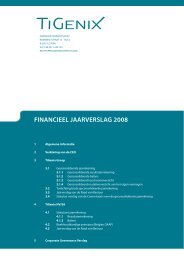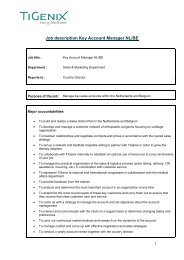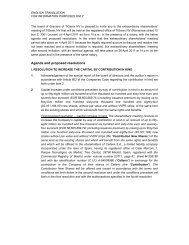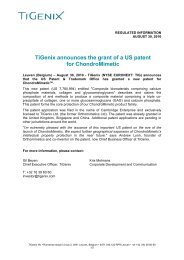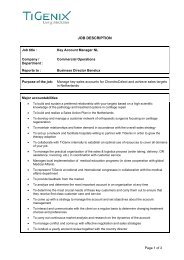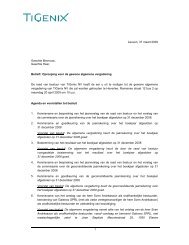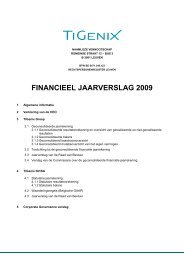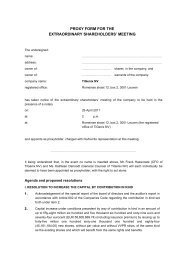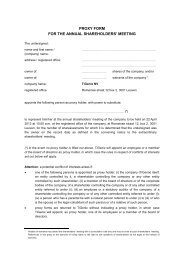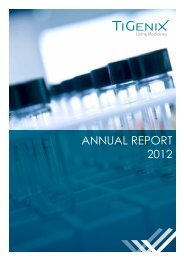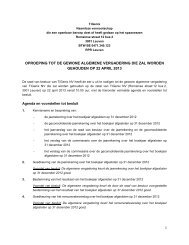ANNUAL FINANCIAL REPORT 2010 2010 - TiGenix
ANNUAL FINANCIAL REPORT 2010 2010 - TiGenix
ANNUAL FINANCIAL REPORT 2010 2010 - TiGenix
- No tags were found...
You also want an ePaper? Increase the reach of your titles
YUMPU automatically turns print PDFs into web optimized ePapers that Google loves.
The Company is also ensuring high quality of the treatmentwith the product and the associated procedures by anextensive training program for the health care providers. Thisincludes training on the best conditions for obtaining thepatient’s biopsy, for the implantation procedure, and for thepatient’s rehabilitation following the re-implantation of thecells. As part of the biopsy procedure standardization, theCompany uses a CE marked biopsy tool (the ChondroCelectHarvester) that was developed in cooperation with MedInvents(Belgium).Indication and target marketAccording to current medical practice, ICRS Grade 3-4 fullthicknesscartilage defects (lesions in which underlying boneis exposed) above 2-3 cm² are indicated for treatment with ACI.No accurate market data are available for this specific indication.Based on an analysis of the number of arthroscopies and theincidence of different types of cartilage defects and patientdemographics 33 , <strong>TiGenix</strong> estimates the incidence of grade3-4 cartilage defects to be over 1.5 million cases worldwide.Focussing on the target population with the highest expectedbenefit, i.e. patients with an early onset of symptoms (< 3 years),a lesion size of more than 2 cm2, a lesion located on the femoralcondyle and patients aging between 18 and 50 years, the totalnumber of eligible patients is estimated to be approximately140,000 worldwide. More than half of these eligible patientsare believed to be located in the EU and the US. This relativehigher amount of eligible patients as compared to the restof the world is a result of the proportionally higher amountof diagnostic arthroscopies that is performed in the EU andthe US. The markets in other areas such as Japan, Australia,India and China also offer significant potential and could beaddressed now that the EMA regulatory approval has beenobtained.Clinical validationThe efficacy of ChondroCelect was studied in a PhaseIII, multicenter, prospective, randomized controlled trial,the TIGACT01-study. ChondroCelect was compared tomicrofracture in the repair of single symptomatic cartilagelesions between 1 and 5 cm² on the femoral condyles ofthe knee in patients aged 18 to 50 years.Fifty-one patients were treated with ChondroCelect and61 patients with microfracture. Patients could be treatmentnaïveor might have undergone previous arthroscopic or othersurgical repair procedure(s). The median time since onset ofsymptoms was slightly longer in the ChondroCelect group thanin the microfracture group (2.0 years vs. 1.6 years).The primary analysis of the data, at 18 months post treatment,demonstrated that the primary objective of the TIGACT01 trialwas met:• at 1 year following treatment, ChondroCelect formedregenerated tissue that was superior to the repair tissueformed following microfracture as determined byhistological analysis of biopsies taken 12 months aftertreatment. The repair tissue formed by patients treated withChondroCelect was found to be less fibrous and to displayfeatures indicative of more durable hyaline-like cartilage;• at 6, 12 and 18 months clinical outcome was similar for bothtreatment groups with a slight advantage in improvementfrom baseline witnessed in patients treated usingChondroCelect.The later analysis of the longer-term data (up to 36 months)demonstrated a continuous improvement in both treatmentarms and a larger overall clinical benefit for the ChondroCelect(CCI) group versus the microfracture group.The short-term results of the pivotal study were publishedin the American Journal of Sports Medicine 34 , a leading peerreviewed orthopaedic journal. This publication was honouredwith the prestigious Hughston Award in July 2009, an awardthat is given by the American Orthopedic Society for SportsMedicine (AOSSM) to the most outstanding paper of theyear published in the American Journal of Sports Medicine.The winning paper was chosen by a panel of AJSM editorsand reviewers. The 36 months data were published in theNovember 2009 issue of the American Journal of SportsMedicine 35 .33 Curl et al., Arthroscopy 1997; Hjelle et al., Arthroscopy 2002; Åroen et al., AmJ Sports Med 2004; Widuchowski et al., Knee 2007; Millennium ResearchGroup, 2008; Marketstrat® Inc., 2008A. Åroen et al, Am J Sports Med, Vol 32,N0 1, 2004: 211-215.34 Saris, Vanlauwe et al., Am J Sports Med., Feb 2008;36(2):235-46.35 Saris, Vanlauwe et al., Am J Sports Med., Nov 2009;37 Suppl 1:10S-19S.116 • <strong>TiGenix</strong> • Rights Offering



